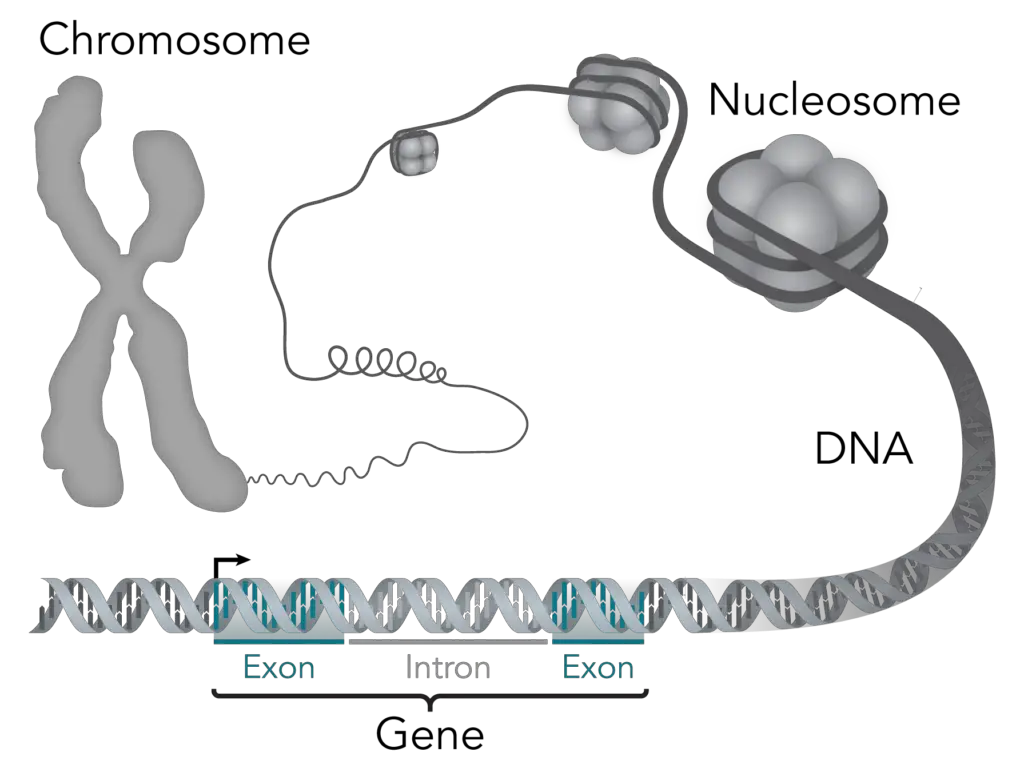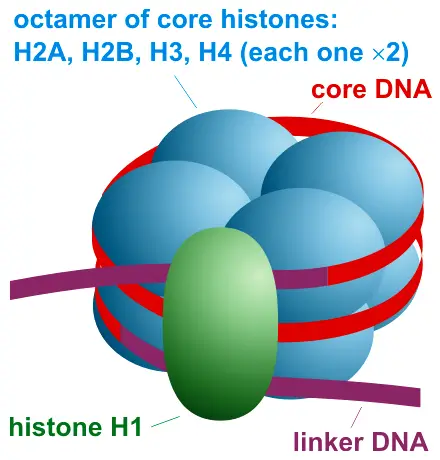(Structure of Chromosome) – What Are Chromosomes Made of?
Each chromosome is made up of a single supercoiled DNA molecule packaged with histone proteins. Histones are the major structural proteins of chromosomes.
Both coding and non-coding DNA polynucleotides that are found in the chromosome are held together by histone proteins.
A chromosome is formed when the DNA double helix structure condenses and wraps around 8 histone proteins forming a nucleosome. That’s also how a chromatin fiber is formed.
The chromatin fibres look like a “beads on string” structure. It’s due to the presence of nucleosomes that present such a structure to the chromosome.
The DNA of all eukaryotes is wrapped around positively charged histone protein octamer to form a nucleosome.
Histones that are found in the chromosomes include a pair of histones H2A, H2B, H3, and H4. Although in some cases other histone variants may also be found (e.g., H2A.Z, MacroH2A, H2a.Bbd, H2A.lap1, H2A.X, H3.3, CenH3, and others).
Histones are rich in lysine and arginine amino acids that are positively charged.
The chromatin fiber remains present in the cell’s nucleolus. During the interphase stage of cell division (mitosis or meiosis), chromatin gets in its least condensed state and appears loosely distributed throughout the nucleus.
It’s only during the prophase, metaphase, anaphase stages of cell division when the chromosomes become visible.
And, it is only during the interphase, telophase, and cytokinesis stages of cell division that the chromosomes are no longer visible.
After the cell division is over, chromosomes become chromatin fibers again.
Chromosomes are Made Of:
Each Chromosome is up made of:
- A single DNA molecule: A DNA molecule is referred to the whole long DNA strand that coils and supercoils itself to take the shape of a chromosome during cell division.
- Histone Proteins: Generally, 8 Histone proteins (also called a histone octamer) form a bead-like structure around which the DNA takes 1.7 turns to form a nucleosome.

This diagram shows how a very long DNA strand is coiled and then supercoiled to form a very small size in order to fit in a portion inside the chromosome.
(Image: Thomas Splettstoesser (www.scistyle.com) / CC BY-SA)
1. A single DNA molecule
Yes, it is a single DNA molecule that coils and supercoils itself to form a chromosome. A chromosome is made up of the compressed, packaged, and supercoiled form of a DNA molecule.
If we talk about the uncoiled DNA, then DNA is larger than the chromosome. And if we talk about the coiled DNA, then DNA is smaller than the chromosome.
When DNA gets coiled, it becomes smaller in size just in order to fit the nucleus of the cell. This is known as DNA packaging.
So, we can say that the chromosome when present, is bigger than the DNA because millions of nucleotides of DNA add up to form a Chromosome.
On average, a single human chromosome consists of a coiled DNA molecule that is about 2 inches long.
And, if that same 2 inches long DNA molecule gets uncoiled then it can gain 109 times more length than that of a chromosome.
The smallest human chromosome is Chromosome Y which has a length of 20 mm with 57,227,415 bp of DNA.
And, the largest human chromosome is Chromosome 1 which has a length of 85 mm with 248,956,422 bp of DNA.
If you talk about the order of packaging, then DNA → Genes → Chromosome. This means that DNA coils itself to make Genes, and Genes further supercoils itself to produce Chromosomes.

2. Histone Proteins
Yes, histones are the major structural proteins of the DNA. Histone proteins give the DNA the shape and the power to compress and supercoil itself more and more in order to take the shape of a chromosome whenever required.
Histones are always found in close association with the DNA inside the nucleus and help condense it further.
Histone gives structural support to the DNA to wrap around its octamer (8 histone proteins) thus leading to DNA coiling in order to fit it inside the cell’s nucleus.
Histones give a positive charge to the nucleosome, and thus the negatively charged DNA strand gets wrapped around the histone octamer.
Electrostatic interactions can be seen between the histone octamer and the wrapped DNA thus, helping the DNA to compress and coil.
Some variants of histones are associated with the regulation of gene expression. And so, they are very important for the regulation of genes.
A nucleosome is a structure formed by 8 histone proteins. The 8 histone proteins are also called together as a histone octamer. This histone octamer forms a bead or core around which the DNA wraps 1.7 times.
The histone octamer core is made up of a pair of H2A, H2B, H3, and H4 histone proteins. H1 and H5 are the linker histones that are found at the entrance and exit sites of the nucleosome and lock the DNA in place.
DNA and histones are packed together to become nucleosome, various nucleosomes pack together to form chromatin, and chromatin forms chromatids of chromosomes.
Is a chromosome made up of chromatin?
Yes, a chromosome is made up of chromatin fiber. Chromosomes are finely packaged and compressed structure of chromatin.
Chromatin simply looks like a “beads on string” structure. The beads are the various nucleosomes condensed in one place.
The primary function of chromatin is to efficiently package DNA into a small volume to fit it into the nucleus of a cell and protect the DNA structure and sequence.
Packaging of the DNA molecule into chromatin allows for the cell divisions like mitosis and meiosis to take place by preventing chromosome breakage. This also controls gene expression and DNA replication in the cell.
Chromatins are usually loosely held in the nucleolus of the cell. This gives the nucleolus a dark-concentrated appearance under the microscope.
The DNA packaging concept states that the chromatin is composed of DNA and histones that are packaged into thin, stringy fibers. The chromatin undergoes further condensation to form the chromosome.
It is also important to note that, chromosomes aren’t always visible. They are only visible during the prophase, metaphase, anaphase stages of cell division.
During the other times, chromatins remain intact in the nucleolus of the cell as the highly compressed DNA molecule.
Are chromosomes made up of genes?
Yes, chromosomes are made up of genes. Genes are small sections or chunks of DNA that can code for a particular protein.
DNA molecule is bigger than a gene. A gene is just only a section of a DNA molecule, and a chromosome contains hundreds to thousands of genes.
The genes on each chromosome are arranged in a particular sequence, and each gene has a particular location on the chromosome called its locus.
In each human diploid cell, there are 23 pairs (46 nos.) chromosomes. One such human Y chromosome contains over 200 genes, at least 72 of which code for proteins. These 200 genes can have about 58 million base pairs of DNA.
DNA molecule is so long that it can have both coding and non-coding DNA sequence. Whereas, genes always consist of coding DNA sequences only in a chromosome.
Is a chromosome part of DNA?
Yes, a chromosome is a part of a long DNA strand that can have about 200+ genes and can have about 58 million base pairs of DNA.
In the nucleus of each cell, the DNA molecule is packaged into thread-like structures called chromosomes. Each chromosome is made up of DNA tightly coiled many times around proteins called histones that support its structure.
DNA is so much compressible that a DNA helix with a diameter of 2nm (2 x 10-9 m) can be supercoiled to become a chromatid of 700nm (700 x 10-9 m) diameter or so. A chromosome consists of two such chromatids attached together.
If DNA is the chemical unit of hereditary then, a chromosome containing various genes is the carrier of hereditary from one generation to the next.
In each living human cell’s nucleus, there is a DNA of 2 metres length. So, the DNA packaging allows the 7 billion base pairs of the DNA in each diploid cell’s nucleus to fit into space of just 6 microns across in the form of chromatins.
And if, those chromatins do not compress further into chromosomes, then there will be a lot of wastage of energy in transferring the genetic information from one generation to the next, and in some cases, the complete transfer of genetic information may even fail.
So, the packaging of DNA into chromosomes is a must for proper genetic information transfer to take place with ease and also with the less use of biochemical energy. This also shows that the chromosome is a part of DNA.
Is the chromosome part of the nucleus?
Chromosomes are actually not part of the nucleus. It’s because when the structure of the chromosomes are visible, then the nucleolus and the nuclear membrane is not visible.
This happens because, the DNA of the cell usually remains in the form of chromatin fibers inside the nucleus and mostly inside the nucleolus of the cell.
Chromosomes are only visible during the cell division stages of prophase, metaphase, and anaphase only. And these stages are characterized by the breakdown of the nucleolus and nuclear envelope for proper cell division to take place.
When the prophase, metaphase, and anaphase stages of the cell division have been completed, the nucleolus and nuclear envelope reappear and chromosomes turn to chromatins again.
So, that’s why it would be wrong to say that chromosomes are thread-like structures located inside the nucleus of cells.
But, it would be always right to say that chromatins are fiber-like structures located inside the nucleus of cells.
Also note that, different cells take different lengths of time to complete the cell cycle. A typical human cell might take about 24 hours to divide, but fast-cycling mammalian cells, like the ones that line the intestine, can complete a cycle every 9-10 hours when they’re grown in culture.
So, chromosomes can be visible very often inside the nuclear membrane of those cells where fast cell-cycling or cell division occurs.
Maybe that’s why it would also be partially correct to say that chromosomes are present in the nucleus of the cell.
Hope, you got my point!
